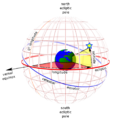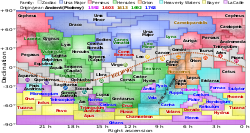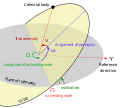In solar observation and imaging, coordinate systems are used to identify and communicate locations on and around the Sun. The Sun is made of plasma,...
9 KB (880 words) - 02:30, 16 December 2024
ecliptic coordinate system is a celestial coordinate system commonly used for representing the apparent positions, orbits, and pole orientations of Solar System...
14 KB (1,331 words) - 02:25, 16 December 2024
degrees (°). The first galactic coordinate system was used by William Herschel in 1785. A number of different coordinate systems, each differing by a few degrees...
15 KB (1,383 words) - 10:24, 1 August 2024
selenographic coordinates for the Moon. The coordinate systems for almost all of the solid bodies in the Solar System were established by Merton E. Davies of...
19 KB (2,166 words) - 18:42, 29 March 2025
The horizontal coordinate system is a celestial coordinate system that uses the observer's local horizon as the fundamental plane to define two angles...
9 KB (944 words) - 04:39, 7 January 2025
Earth-fixed coordinate system (acronym ECEF), also known as the geocentric coordinate system, is a cartesian spatial reference system that represents...
9 KB (912 words) - 16:39, 14 December 2024
reference systems that are in use, and forms the basis for most others. Although latitude and longitude form a coordinate tuple like a cartesian coordinate system...
23 KB (2,540 words) - 22:18, 14 May 2025
The equatorial coordinate system is a celestial coordinate system widely used to specify the positions of celestial objects. It may be implemented in spherical...
17 KB (1,657 words) - 07:37, 20 March 2025
The solar azimuth angle is the azimuth (horizontal angle with respect to north) of the Sun's position. This horizontal coordinate defines the Sun's relative...
11 KB (1,518 words) - 02:43, 7 September 2024
Differential rotation in stars Solar coordinate systems Magnetohydrodynamics Orbital period Tachocline Zell, Holly (2015-03-02). "Solar Rotation Varies by Latitude"...
13 KB (1,618 words) - 10:40, 29 April 2025
Coordinated Universal Time (UTC) is the primary time standard globally used to regulate clocks and time. It establishes a reference for the current time...
52 KB (6,081 words) - 18:56, 16 May 2025
{\displaystyle {\mathbf {k} }} are the basis vectors in the ECEF coordinate system. Now the cosine of the solar zenith angle, θ s {\displaystyle \theta _{s}} , is simply...
8 KB (1,226 words) - 09:50, 2 May 2025
In astronomy, coordinate systems are used for specifying positions of celestial objects (satellites, planets, stars, galaxies, etc.) relative to a given...
29 KB (3,971 words) - 18:25, 17 April 2025
Position of the Sun (redirect from Solar declination)
location. This is the coordinate system normally used to calculate the position of the Sun in terms of solar zenith angle and solar azimuth angle, and the...
25 KB (3,398 words) - 22:39, 16 April 2025
spacetime coordinate system relative to an implied observer. In many (but not all) coordinate systems, an event is specified by one time coordinate and three...
11 KB (1,514 words) - 16:37, 13 November 2023
within the Solar System. The orientation of the BCRS coordinate system coincides with that of the International Celestial Reference System (ICRS). Both...
8 KB (999 words) - 04:14, 12 January 2025
Barycenter (astronomy) (redirect from Solar System Barycenter)
International Celestial Reference System (ICRS) is a barycentric coordinate system centered on the Solar System's barycenter. The barycenter is one of...
16 KB (1,541 words) - 20:40, 14 January 2025
The selenographic coordinate system is used to refer to locations on the surface of Earth's moon. Any position on the lunar surface can be referenced...
5 KB (573 words) - 02:09, 19 December 2024
(primary coordinates) GPX (secondary coordinates) Solar Energy Generating Systems (SEGS) is a concentrated solar power plant in California, United States. With...
25 KB (1,741 words) - 11:29, 15 August 2024
interplanetary spacecraft in the Solar System. It is equivalent to the proper time experienced by a clock at rest in a coordinate frame co-moving with the barycenter...
6 KB (963 words) - 09:53, 17 January 2025
Ecliptic (category Astronomical coordinate systems)
equinoxes. Formation and evolution of the Solar System Invariable plane Protoplanetary disk Celestial coordinate system Strictly, the plane of the mean orbit...
29 KB (2,903 words) - 23:59, 28 March 2025
night, and a better ability to orient to face the Sun. Space-based solar power systems convert sunlight to some other form of energy (such as microwaves)...
112 KB (12,829 words) - 02:05, 30 April 2025
The perifocal coordinate (PQW) system is a frame of reference for an orbit. The frame is centered at the focus of the orbit, i.e. the celestial body about...
6 KB (1,037 words) - 03:50, 27 January 2025
Zodiac (category Astronomical coordinate systems)
longitude. In modern astronomy, the ecliptic coordinate system is still used for tracking Solar System objects. The English word zodiac derives from...
66 KB (6,793 words) - 10:47, 20 May 2025
Timekeeping on Mars (redirect from Mars Coordinated Time)
Bibcode:2014Icar..229..340K. doi:10.1016/j.icarus.2013.11.015. "New Coordinate Systems for Solar System Bodies". International Astronomical Union. Retrieved 18 September...
50 KB (5,975 words) - 09:49, 22 May 2025
photovoltaic cells that convert sunlight directly into electricity, solar thermal systems convert it into heat. They use mirrors or lenses to concentrate...
73 KB (8,476 words) - 17:33, 11 April 2025
sphere. For a geographic coordinate system of the Earth, the fundamental plane is the Equator. Astronomical coordinate systems have varying fundamental...
2 KB (178 words) - 15:13, 9 January 2025
First point of Aries (category Astronomical coordinate systems)
southern), used as a reference point in celestial coordinate systems. In diagrams using such coordinate systems, it is often indicated with the symbol ♈︎. Named...
6 KB (723 words) - 23:07, 29 January 2025
The solar wind is a stream of charged particles released from the Sun's outermost atmospheric layer, the corona. This plasma mostly consists of electrons...
57 KB (6,717 words) - 23:00, 4 May 2025
plane. The coordinate system defined that uses the orbital plane as the x y {\displaystyle xy} plane is known as the perifocal coordinate system. For launch...
4 KB (388 words) - 18:03, 25 April 2024






















